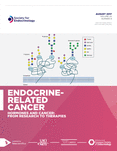WOMEN IN CANCER THEMATIC REVIEW: New roles for nuclear receptors in prostate cancer
-
Figure 1
Schematic diagrams of nuclear receptor structures and DNA binding. (A) Representative images of different nuclear receptor (NR) types, comparing their overall size and highlighting the amino, N-terminal domain (NTD), the DNA-binding domain (DBD) and ligand-binding domain (LBD). The AR is used as an example to highlight these regions, as well as the AF1 and AF2 sites. (B) NRs interact with DNA in pairs, with either the same NR (homodimer) or another NR (heterodimer), or bind singularly as a monomer. Each NR has a specific mode of binding resulting in gene transcription.
-
Figure 2
Nuclear receptor alterations in prostate cancer. (A) List of 48 nuclear receptors (NR) grouped based on their cognate ligands. (B)TCGA data of copy number alterations (CNA) of all NRs in prostate cancer samples. (C) TCGA data of mutations detected in all NRs in prostate cancer samples. (D) Pie chart demonstrating the incidence of mutations and CNAs in NRs for each NR group.
- © 2016 Society for Endocrinology












